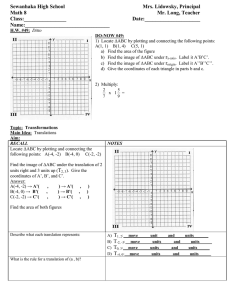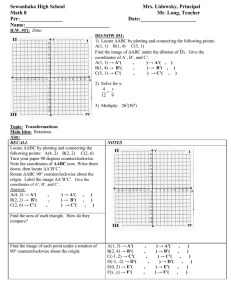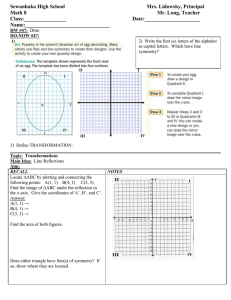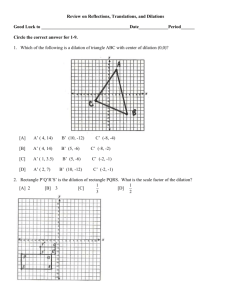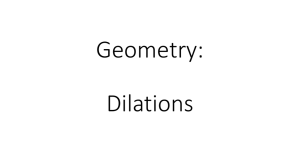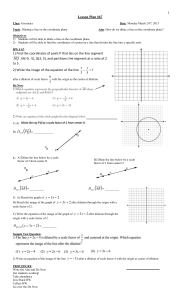Math 8 Lesson Plan 50 Dilations class outline for students.doc
advertisement
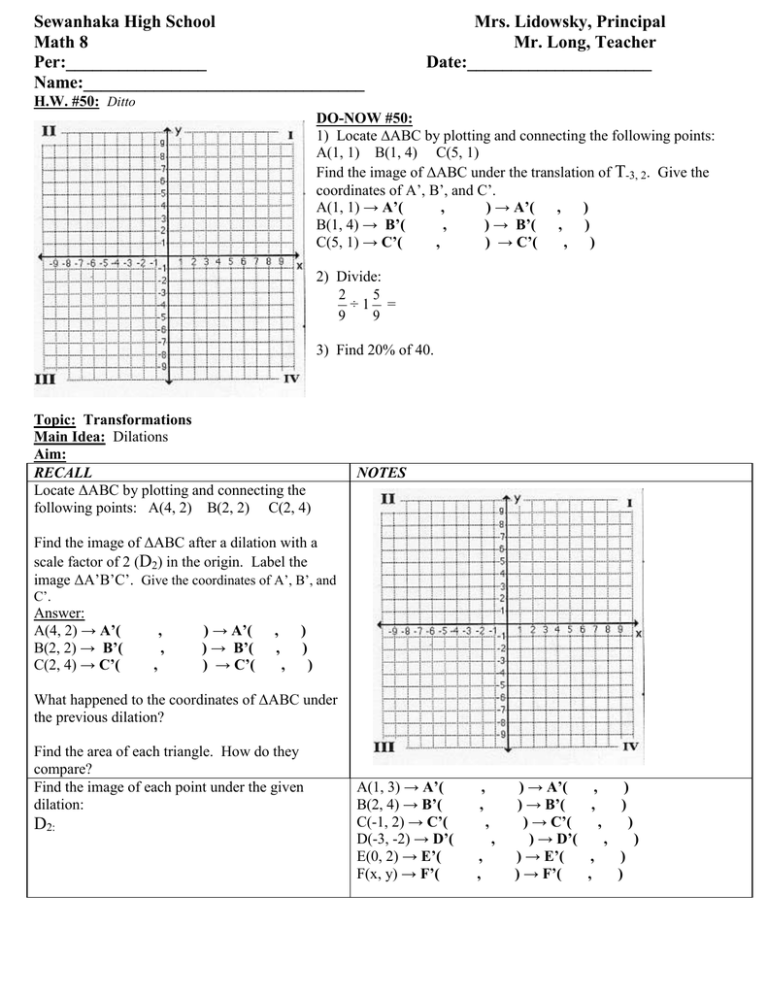
Sewanhaka High School Math 8 Per:________________ Name:________________________________ Mrs. Lidowsky, Principal Mr. Long, Teacher Date:_____________________ H.W. #50: Ditto DO-NOW #50: 1) Locate ∆ABC by plotting and connecting the following points: A(1, 1) B(1, 4) C(5, 1) Find the image of ΔABC under the translation of T-3, 2. Give the coordinates of A’, B’, and C’. A(1, 1) → A’( , ) → A’( , ) B(1, 4) → B’( , ) → B’( , ) C(5, 1) → C’( , ) → C’( , ) 2) Divide: 2 5 ÷1 = 9 9 3) Find 20% of 40. Topic: Transformations Main Idea: Dilations Aim: RECALL Locate ΔABC by plotting and connecting the following points: A(4, 2) B(2, 2) C(2, 4) NOTES Find the image of ΔABC after a dilation with a scale factor of 2 (D2) in the origin. Label the image ΔA’B’C’. Give the coordinates of A’, B’, and C’. Answer: A(4, 2) → A’( B(2, 2) → B’( C(2, 4) → C’( , , , ) → A’( ) → B’( ) → C’( , , ) ) , ) What happened to the coordinates of ΔABC under the previous dilation? Find the area of each triangle. How do they compare? Find the image of each point under the given dilation: D2: A(1, 3) → A’( B(2, 4) → B’( C(-1, 2) → C’( D(-3, -2) → D’( E(0, 2) → E’( F(x, y) → F’( , , , , , , ) → A’( , ) ) → B’( , ) ) → C’( , ) ) → D’( , ) ) → E’( , ) ) → F’( , ) Find the image of each point under the given dilation: D3: Question: What is the rule for a dilation of a in the Origin? Locate ΔABC by plotting and connecting the following points: A(4, 2) B(2, 2) C(2, 4) Find the image of ΔABC after a dilation with a scale factor of ½ (D½) in the origin. Label the image ΔA’’B’’C’’. Give the coordinates of A’’, B’’, and C’’. Answer: A(4, 2) → A’’( , ) → A’’( , ) B(2, 2) → B’’( , ) → B’’( , ) C(2, 4) → C’’( , ) → C’’( , ) What happened to the coordinates of ΔABC under the previous dilation? Find the area of each triangle. How do they compare? Locate ∆GHI by plotting and connecting the following points: G(2, 0) H(0, 1) I(3, 2). Find the image of ∆GHI under D2: a) D2 Give the coordinates of G’, H’, and I’. Answer: G(2, 0) → G’( , ) → G’( , H(0, 1) → H’( , ) → H’( , I(3, 2) → I’( , ) → I’( , ) ) ) b) D3 Give the coordinates of G’’, H’’, and I’’. Answer: G(2, 0) → G’’( H(0, 1) → H’’( I(3, 2) → I’’( Summary: , , , ) → G’’( ) → H’’( ) → I’’( , , , ) ) ) A(1, 3) → A’( B(2, 4) → B’( C(-1, 2) → C’( D(-3, -2) → D’( E(0, 2) → E’( F(x, y) → F’( , , , , , , ) → A’( , ) ) → B’( , ) ) → C’( , ) ) → D’( , ) ) → E’( , ) ) → F’( , )
